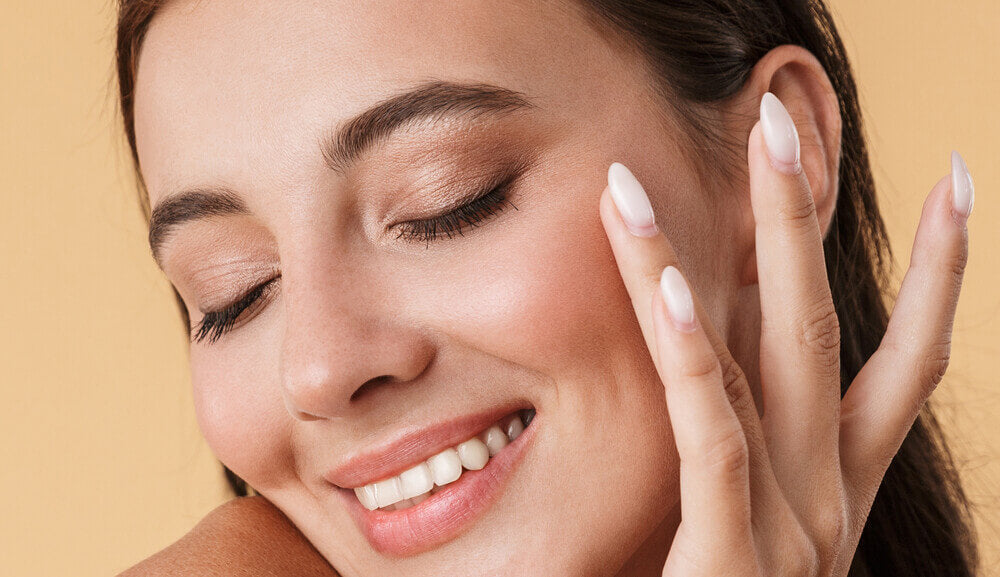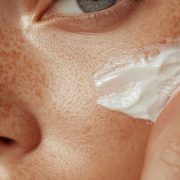Exploring the layers of our skin, and how to achieve optimal skin barrier health
Posted on July 18, 2025 Written by: 100% PURE ®

As we’ve all learned in the past decade, skin care is so much more than absorbing oil and preventing breakouts. Your skin is your body’s largest organ, and it works best when it’s happy and healthy.
But the skin is incredibly complex, and requires more than cleansing and moisturizing to stay in tip-top shape. And one of the keys to healthy skin is a healthy skin barrier.
But what does one do when the skin barrier becomes damaged?
In this article, we’re going to talk about repairing the skin barrier. But first, let’s break it down:

“Micro” means extremely small, and “biome” is a living community of organisms in a habitat. So a “microbiome” is a tiny world of living organisms – in this case, bacteria living on the surface of our skin.
While the thought might make your cringe, our microbiome is nothing to fear. These microbes are here to protect our skin from the infiltration of ‘bad’ bacteria, which can be harmful to our skin and our health.
The acid mantle is the thin, almost tacky film that rests on the skin’s surface (just below the microbiome). With help from sebum, it works to keep our skin healthy and lubricated while acting as a shield from pathogens and impurities.
Sebum consists of triglycerides and fatty acids which, when mixed with amino acids from our sweat, keep the pH more on the acidic side. This is ideally between 4.7 and 5.75, a range that is virtually inhospitable to pathogens.
So while having too much sebum in the acid can produce issues like clogged pores, it’s essential to keeping your skin barrier safe and healthy.
Beneath the acid mantle is the lipid barrier, which consists mainly of cholesterol, fatty acids, and ceramides. These are designed to protect against the movement of water and electrolytes.
Through this, the lipid barrier works not only to keep water in so the skin stays hydrated, but also to keep pathogens from entering.
Some consider the acid mantle to be the skin’s “chemical” line of defense, while the lipid barrier is considered its “physical”.
Beneath the lipid barrier, acid mantle, and microbiome is our epidermis, or outer skin. It’s the third line of defense in our skin barrier.
The epidermis is the skin we see every day. It provides us with pigment, and protects our bodies from UV radiation. In the epidermis, there are three major functions: protection, regulation, and sensation.
So we know how the skin barrier works when it’s healthy, but what about when it becomes damaged?
When the skin barrier becomes weakened, dry skin is more likely to occur since it’s less able to prevent trans-epidermal water loss. The skin may feel tight after every cleanse, and may even become flaky.
The skin barrier will also have a harder time defending against invading microbes, and this can lead to a number of issues. On top of that, premature aging becomes more of a risk for a frequently parched skin barrier.

When your skin barrier becomes damaged, it’s all too easy to (quite literally) feel uncomfortable in your own skin.
Luckily, the skin barrier can repair itself over time, and there are ways we can help the process!
When we talk about , balancing the pH is key. But when we talk about repairing the skin barrier, it’s all about hydrating, nourishing, and keeping things gentle for the skin.
#1: Use Skin Barrier Repair Products
There are products on the market that can help repair the skin barrier, and they can be identified by the ingredients they contain.
When shopping for a barrier repair product, check for ingredients that can help restore the skin barrier like , ceramides, and fatty acids. Soothing ingredients like aloe vera, rose hydrosol, and can also help ease redness and inflammation that may occur with a damaged skin barrier.
Our contains sea kelp, algae extract, and chia seed to help restore the skin barrier for a healthier microbiome and a restored glow. There’s also our , which can soothe irritated skin and replenish moisture.
#2: Switch Up Your Cleansing Tactics
is one of the most common causes of a damaged skin barrier, especially when using harsh ingredients like and artificial fragrance.
Instead, cleanse with products that hydrate and nourish your skin while cleansing it. If you’re using makeup wipes or harsh makeup removers, opt instead for cleansing oils and cleansing balms. Our , for instance, moisturizes the skin while melting off makeup and dirt with the help of avocado, coconut, and olive leaf extract.
And cleansing balms work best when paired with a non-stripping gel, like our , or for even more hydration, a cleansing milk, like our .
#3: Up Your Moisture Game
Perhaps above all, hydrating products are going to be especially helpful. Those with a thick, occlusive consistency are especially beneficial for preventing trans-epidermal water loss as your skin barrier heals.
While a daily moisturizer is still essential, try finishing off your nighttime with a rich, balmy moisturizer that will lock in water while you sleep. Our and our are excellent options!
#4: Re-Examine Your SPF Strategy
When the skin goes unprotected, the sun is going to cause damage, both short-term and long-term. If the summer sun’s got you burnt, brush up on and make SPF a priority.
If you haven’t already, start making an SPF a part of your daily skincare regimen, ideally a physical sunscreen that uses minerals to shield your skin from the sun.
Our protects the skin from harmful UV rays while rehydrating with green tea and aloe. Alternatively, our protects the skin from the sun with minerals, which are reinforced by lycopene, an antioxidant found in tomatoes.
Don’t Skip the Finishing Steps: Barrier-Loving Boosters
When rebuilding your skin barrier, consistency is key—but so is choosing the right finishing products to amplify and seal in results. After your serum and moisturizer, a strategic layer of botanical-rich support can help restore strength and resilience to compromised skin.
Here are three gentle-yet-potent 100% PURE® products that help nourish, protect, and maintain optimal skin barrier health:
1.
This ultra-nourishing daily cream is packed with seaberry (aka sea buckthorn), which is rich in omega fatty acids—ideal for reinforcing the lipid barrier. It also contains aloe and acai oil to deeply hydrate and reduce inflammation, making it perfect for dry, sensitive, or post-damaged skin.
2.
If your skin barrier is stressed, even water and washcloth friction can feel like too much. This no-rinse micellar water gently lifts away dirt, oil, and makeup without disrupting your skin’s microbiome or pH. Infused with rose hydrosol and calendula, it cleanses while calming and rebalancing your skin.
3.
Light as air, this cloud-like foam delivers a soothing cleanse with cucumber, aloe, and hyaluronic acid—ideal for skin that’s inflamed or prone to irritation. It helps to keep the skin clean without stripping away essential lipids or moisture.
Adding these skin barrier-friendly products into your daily ritual ensures that every step of your routine supports recovery and resilience—without risking setbacks.
Frequently Asked Questions About Skin Barrier Repair
1. How do I know if my skin barrier is damaged?
Signs of a damaged skin barrier include persistent dryness, tightness, flaking, increased sensitivity, redness, and breakouts. Your skin may sting when applying products that normally feel fine, and it might look dull or rough in texture. These symptoms indicate the skin’s protective layers are compromised.
2. What ingredients should I avoid if my skin barrier is damaged?
Avoid harsh surfactants (like SLS), denatured alcohol, synthetic fragrances, and strong exfoliants (like glycolic acid or physical scrubs). These can worsen inflammation and further weaken your barrier. Instead, choose gentle, fragrance-free products rich in ceramides, fatty acids, and antioxidants.
3. Can I exfoliate if I’m trying to repair my skin barrier?
It depends on your skin’s condition. If your skin is very irritated or flaky, it’s best to skip exfoliation for 1–2 weeks. Once healing has begun, you can reintroduce gentle exfoliants like lactic acid or fruit enzymes—1x per week max—to encourage healthy skin turnover without causing stress.
4. How long does it take to repair a damaged skin barrier?
Mild skin barrier damage may heal within 1–2 weeks with the right care, while more severe damage can take a month or longer. The timeline depends on how consistently you use barrier-repairing products and avoid triggers. Stick to hydrating, calming routines and limit product testing during this time.
5. Does sunscreen help repair the skin barrier?
Sunscreen doesn’t repair, but it prevents further damage. UV exposure weakens the skin’s protective layers, so daily use of broad-spectrum SPF is essential—especially when your barrier is already vulnerable. Mineral-based SPFs with zinc or titanium dioxide are gentler for compromised skin.




